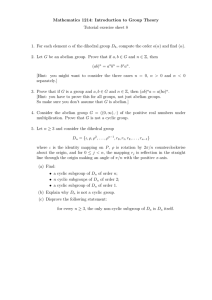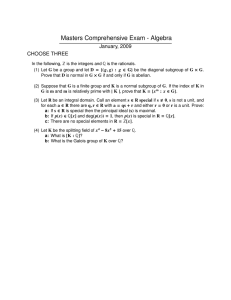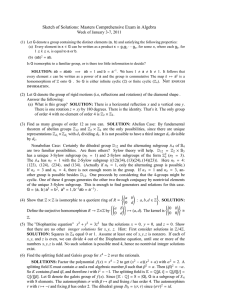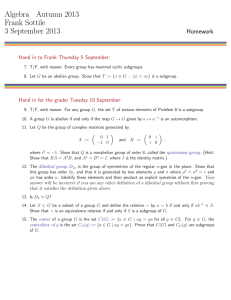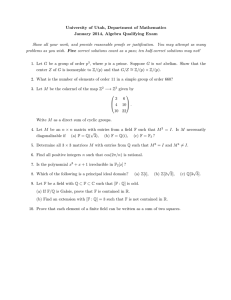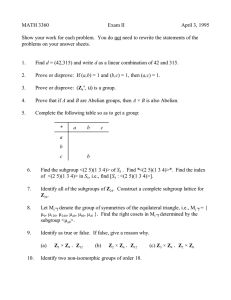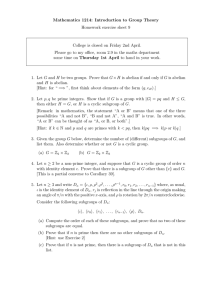Mathematics 1214: Introduction to Group Theory
advertisement
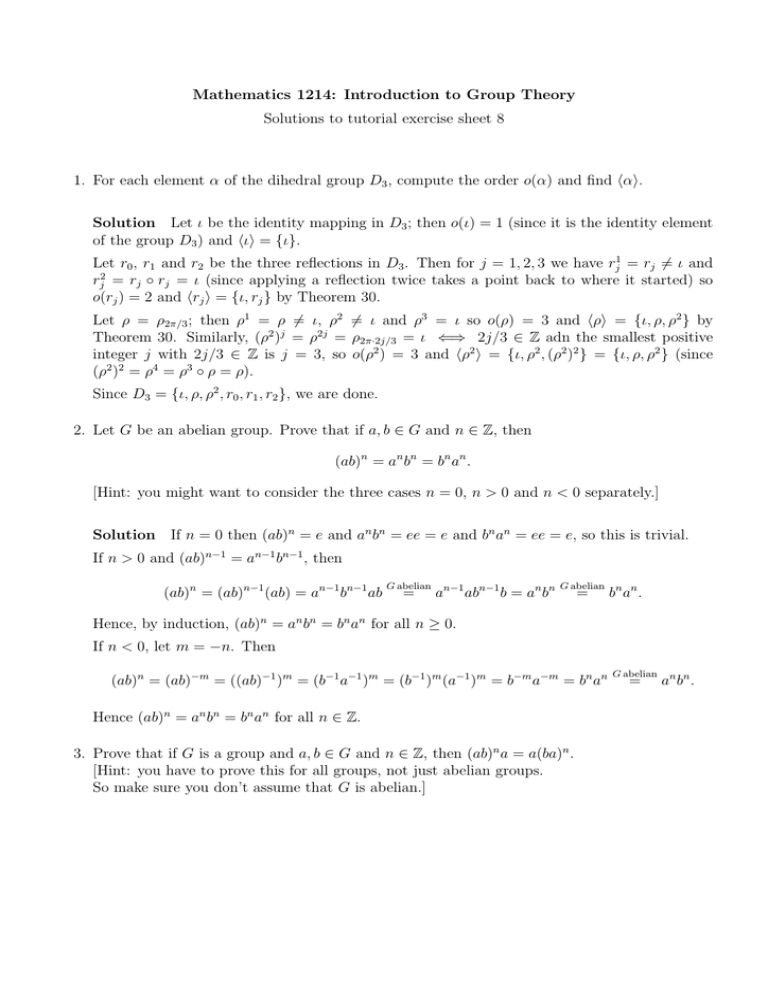
Mathematics 1214: Introduction to Group Theory
Solutions to tutorial exercise sheet 8
1. For each element α of the dihedral group D3 , compute the order o(α) and find hαi.
Solution Let ι be the identity mapping in D3 ; then o(ι) = 1 (since it is the identity element
of the group D3 ) and hιi = {ι}.
Let r0 , r1 and r2 be the three reflections in D3 . Then for j = 1, 2, 3 we have rj1 = rj 6= ι and
rj2 = rj ◦ rj = ι (since applying a reflection twice takes a point back to where it started) so
o(rj ) = 2 and hrj i = {ι, rj } by Theorem 30.
Let ρ = ρ2π/3 ; then ρ1 = ρ 6= ι, ρ2 =
6 ι and ρ3 = ι so o(ρ) = 3 and hρi = {ι, ρ, ρ2 } by
Theorem 30. Similarly, (ρ2 )j = ρ2j = ρ2π·2j/3 = ι ⇐⇒ 2j/3 ∈ Z adn the smallest positive
integer j with 2j/3 ∈ Z is j = 3, so o(ρ2 ) = 3 and hρ2 i = {ι, ρ2 , (ρ2 )2 } = {ι, ρ, ρ2 } (since
(ρ2 )2 = ρ4 = ρ3 ◦ ρ = ρ).
Since D3 = {ι, ρ, ρ2 , r0 , r1 , r2 }, we are done.
2. Let G be an abelian group. Prove that if a, b ∈ G and n ∈ Z, then
(ab)n = an bn = bn an .
[Hint: you might want to consider the three cases n = 0, n > 0 and n < 0 separately.]
Solution If n = 0 then (ab)n = e and an bn = ee = e and bn an = ee = e, so this is trivial.
If n > 0 and (ab)n−1 = an−1 bn−1 , then
(ab)n = (ab)n−1 (ab) = an−1 bn−1 ab
G abelian
=
an−1 abn−1 b = an bn
G abelian
=
b n an .
Hence, by induction, (ab)n = an bn = bn an for all n ≥ 0.
If n < 0, let m = −n. Then
(ab)n = (ab)−m = ((ab)−1 )m = (b−1 a−1 )m = (b−1 )m (a−1 )m = b−m a−m = bn an
Hence (ab)n = an bn = bn an for all n ∈ Z.
3. Prove that if G is a group and a, b ∈ G and n ∈ Z, then (ab)n a = a(ba)n .
[Hint: you have to prove this for all groups, not just abelian groups.
So make sure you don’t assume that G is abelian.]
G abelian
=
an b n .
Solution If n = 0 then (ab)n = e = (ba)n , so (ab)n a = ea = a and a(ba)n = ae = a, so this is
trivial.
If n > 0 and (ab)n−1 a = a(ba)n−1 , then
(ab)n a = (ab)(ab)n−1 a = (ab)a(ba)n−1 = a(ba)(ba)n−1 = a(ba)n .
By induction, this shows that (ab)n a = a(ba)n for all n ≥ 0.
If n < 0, let m = −n. We have m > 0, so
(ab)m a = a(ba)m =⇒ (ab)−m (ab)m a(ba)−m = (ab)−m a(ba)m (ba)−m
⇐⇒ a(ba)−m = (ab)−m a
⇐⇒ a(ba)n = (ab)n a.
4. Consider the abelian group G = ((0, ∞), ·) of the positive real numbers under multiplication.
Prove that G is not a cyclic group.
Solution Let x ∈ (0, ∞).
If x = 1 then hxi = h1i = {1}, so hxi =
6 (0, ∞).
If x > 1 then · · · < x−2 < x−1 < 1 = x0 < 12 (1 + x) < x < x2 < x3 < . . . , so 21 (1 + x) 6∈ hxi, so
hxi =
6 (0, ∞).
If x < 1 then hxi = hx−1 i and x−1 > 1, so hxi = hx−1 i =
6 (0, ∞) by the previous paragraph.
(Or, you could repeat that argument using the inequalities · · · > x−2 > x−1 > 1 = x0 >
1
(1 + x) > x > x2 > x3 . . . ). So hxi =
6 (0, ∞).
2
Hence for every x ∈ (0, ∞), we have (0, ∞) 6= hxi. So (0, ∞) is not cyclic.
5. Let n ≥ 3 and consider the dihedral group
Dn = {ι, ρ, ρ2 , . . . , ρn−1 , r0 , r1 , r2 , . . . , rn−1 }
where ι is the identity mapping on P , ρ is rotation by 2π/n counterclockwise about the origin,
and for 0 ≤ j < n, the mapping rj is reflection in the straight line through the origin making
an angle of π/n with the positive x-axis.
(a) Find:
• a cyclic subgroup of Dn of order n;
• n cyclic subgroups of Dn of order 2;
• a cyclic subgroup of Dn of order 1.
(b) Explain why Dn is not a cyclic group.
(c) Disprove the following statement:
for every n ≥ 3, the only non-cyclic subgroup of Dn is Dn itself.
2
Solution (a)
• We have ρk = ρ2πk/n = ι ⇐⇒ k/n ∈ Z ⇐⇒ n|k. So o(ρ) = n is the smallest positive
power of ρ giving the identity element. Hence hρi = {ι, ρ, ρ2 , . . . , ρn−1 } is a cyclic subgroup
of order n.
• We have rj 6= ι and rj2 = ι (since reflecting twice takes you back to where you started).
So for j = 0, 1, . . . , n − 1, the subgroup hrj i = {ι, rj } is cyclic of order 2.
• hιi = {ι}.
(b) Dn is not abelian, so it is not cyclic.
(c) Take n = 4 and consider H = {ι, ρπ , r0 , r2 }. It’s not too hard to check that this is a
subgroup of D4 , and it’s clearly not equal to D4 . Either o(x) = 1 or o(x) = 2 for all x ∈ H
(check this!) so |hxi| = o(x) < 4 = |H| for all x ∈ H, so we cannot have H = hxi. So H is not
a cyclic subgroup of D4 .
OR: take n = 6 and observe that D3 ⊆ D6 , since every symmetry of an equilateral triangle is
a symmetry of the enclosing regular hexagon. Since D3 is a non-cyclic group, it’s a non-cyclic
subgroup of D6 .
So we’ve found a counterexample (in fact, two of them) to the statement, so it’s false.
3
